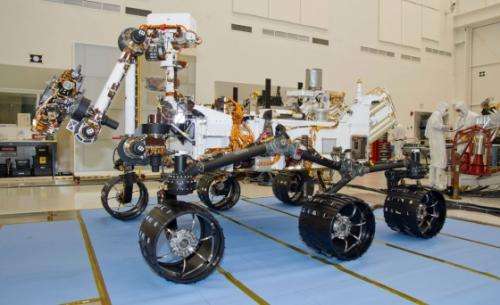Curiosity rover has seen much in first two years on Mars

NASA's Curiosity rover marks two Earth years on Mars this week, and Planetary Science Institute researchers are actively pursuing new knowledge of our neighboring planet.
The Mars Science Laboratory rover, which arrived on Mars slightly more than one Martian year ago, has offered scientists detailed analysis of the planet's geology and mineralogy, as well as clues to past habitability.
The first surface science results from the mission provided the most definitive evidence yet of an ancient stream flow on Mars, according to research led by PSI Senior Scientist Rebecca M.E. Williams, Curiosity science co-Investigator. "This is the first confirmation of sedimentary conglomerates on another planet," Williams said.
"The team's result of river transported sediment is one of the highlights of the mission to date. This was followed up with data from Yellowknife Bay detailing evidence for a lake that was a habitable environment." Williams said.
The first detailed examination of clay mineralogy in its original setting on Mars is offering new insights on the planet's past habitability, research led by PSI Senior Scientist David T. Vaniman has found. Vaniman is the deputy principal investigator for the CheMin (Chemical and Mineralogy) instrument aboard the rover.
The sedimentary rock samples tested were collected at Yellowknife Bay in Gale Crater on Mars. The rover's CheMin X-Ray Diffraction and Fluorescence (CheMin XRD/XRF) instrument analyzed the samples.
"The in situ X-ray diffraction results reveal the presence of smectite, a type of clay mineral typical of soils and sediments that have not been deeply buried, heated, or otherwise altered," Vaniman said. "The X-Ray diffraction data from the mudstone are also important for what they do not detect – clay minerals such as chlorite or illite that would have formed in strongly alkaline or hydrothermal fluids."
"I'm excited about the frequency with which we are seeing conglomerates along our traverse," said PSI Senior Scientist R. Aileen Yingst. "Not only do these layers indicate flowing water, we see different characteristics in various conglomerate layers, meaning that we can begin to interpret how that flowing water changed and evolved through time.
In addition to working with Williams on studying Martian conglomerates, Yingst is deputy principal investigator for the mission's Mars Hand Lens Imager (MAHLI). MAHLI provides Earthbound scientists with close-up views of minerals, textures and structures in Martian rocks and the surface layer of rocky debris and dust.
"It is an accomplishment every time we take a rover 'selfie.' I worked so hard to administer the first selfie through the conservative process of accepting and executing a first-time observation. Now taking a selfie is not necessarily easy, but an accepted, relatively standard operation," Yingst said. "If there's one thing that I can say I helped give to history, it's the image of the rover looking back at us."
"I'm so proud of how beautifully this camera has performed on Mars," Yingst said. "MAHLI has provided us with the clearest idea so far of Martian sedimentary textures, and things will only get more exciting when we get to Mt. Sharp."
PSI scientists Bruce Barraclough, Steven Bender, Nina Lanza, Robert Tokar, and Vaniman are all members of the ChemCam instrument team on Curiosity. In the two Earth years of operations on Mars the ChemCam instrument has collected thousands of chemical analyses by laser induced plasma emission, at ranges up to seven meters. These results have provided a "microprobe" view of rock, soil, and individual mineral compositions. Among the many science results from ChemCam are discoveries of a common abundance of alkaline feldspars and rarer but significant manganese-oxide coatings on some rocks.
The PSI scientists look forward to new discoveries as Curiosity continues it trek on the Martian surface.
Provided by Planetary Science Institute





















